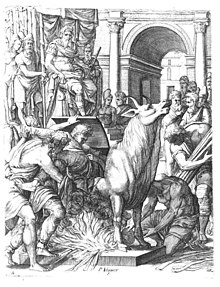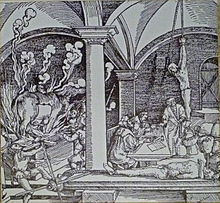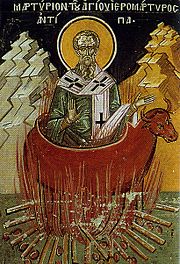Brazen bull
From Wikipedia, the free encyclopedia
For the film, see The Brazen Bull.
Perillos being forced into the brazen bull that he built for Phalaris.
Contents
Reign of Phalaris
The brazen bull (left) depicted on an old engraving
Perillos said to Phalaris: "[His screams] will come to you through the pipes as the tenderest, most pathetic, most melodious of bellowings." Disgusted by these words, Phalaris ordered its horn sound system to be tested on Perillos himself. When Perillos entered, he was immediately locked in, and the fire was set, so that Phalaris could hear the sound of his screams. Before Perillos could die, Phalaris opened the door and took him away. Perillos believed he would receive a reward for his invention; instead, after freeing him from the bull, Phalaris threw him from the top of a hill, killing him. Phalaris himself is said to have been killed in the brazen bull when he was overthrown by Telemachus, the ancestor of Theron.[citation needed]
Possible link to Carthaginian Sacrifice
Biblical scholars link the design of the Brazen Bull to statues of the Carthaginian deity Baal Hammon (often identified with the Biblical Moloch) in which infants were sacrificed alive within a bronze, calf-headed statue of the deity by being placed on the hands of the statue and sliding down into the bronze furnace.[5] The noises of the child's screams were often drowned out by drumming and dancing, since the sacrificial altars did not have the pipes system that the Brazen Bull had (see Tophet). The practices of the city of Tophet are also cited by scholars to be the inspiration for the Brazen Bull because of Akragas' Carthaginian roots.[6]The story of the bull cannot be dismissed as pure invention. Pindar, who lived less than a century afterwards, expressly associates this instrument of torture with the name of the tyrant.[7]
Saint Antipas being roasted alive in a Brazen bull at Pergamon.
Roman persecution of Jews and Christians
The Romans were reputed to have used this torture device to kill some Jews,[citation needed] as well as some Christians, notably Saint Eustace, who, according to Christian tradition, was roasted in a brazen bull with his wife and children by Emperor Hadrian. The same happened to Saint Antipas, Bishop of Pergamon during the persecutions of Emperor Domitian and the first martyr in Asia Minor, who was roasted to death in a brazen bull in AD 92.[8] The device was still in use two centuries later, when another Christian, Pelagia of Tarsus, is said to have been burned in one in 287 by the Emperor Diocletian.The Catholic Church discounts the story of Saint Eustace's martyrdom as "completely false".[9]
Francesco Ferdinandi,
The Martyrdom of St. Eustace. Behind the main altar at the Church of
Sant'Eustachio, Rome, this painting follows the narrative in the Golden Legend: For refusing to sacrifice to the gods, Saint Eustace and his wife and sons are to be enclosed in a Brazen bull which will be heated until they die.
Visigothic kingdom of Toulouse
According to the Chronica caesaraugustana, Burdunellus, a Roman usurper, was roasted in a brazen bull by the king Alaric II in 497.In film
The 2011 film Immortals shows three maidens of an oracle being tortured in a brazen bull.See also
References
- Notes
- "Martyrologium Romanum" (Libreria Editrice Vaticana, 2001 ISBN 88-209-7210-7)
- Bibliography
- Diehl, Daniel; Donnelly, Mark P. (2008), The Big Book of Pain: Punishment and Torture Through History, The History Press, ISBN 978-0-7509-4583-7
- Thompson, Irene (2008), The A to Z of Punishment and Torture: From Amputations to Zero Tolerance, Book Guild Publishing, ISBN 978-1-84624-203-8
External links
| ||




No comments:
Post a Comment